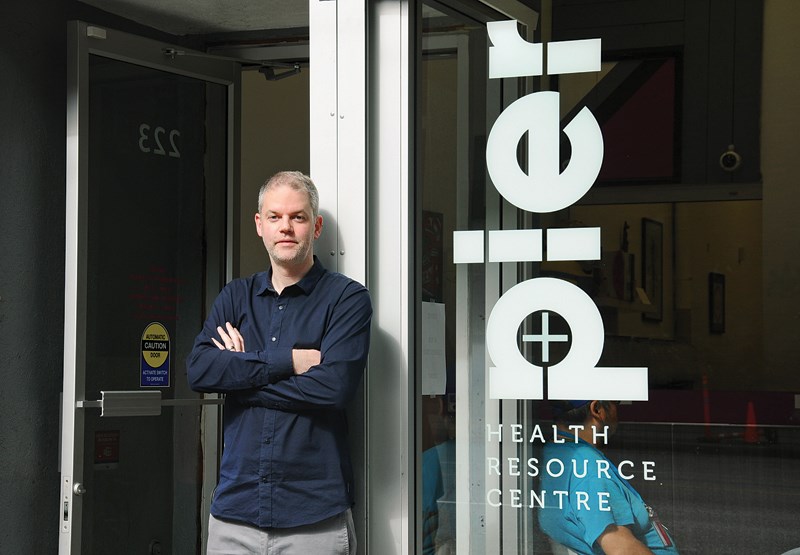Inside his singular moment of triumph was a profound, inalienable feeling of doubt – lurking beneath the celebration like an overactive conscience.
North Vancouver’s Craig Plain had just been named Canada’s pharmacist of the year for 2017. His work – which entails seeing 150 patients each day in his pharmacy and in the parks, shelters, and SROs of the Downtown Eastside – had been recognized.
But as he stood on the stage and on top of his profession to accept the award in a Quebec City ballroom, what Craig Plain mostly felt was conflicted.
About one week before the award the B.C. Coroners Service released statistics on overdose deaths: 136 drug users died in April; 97 per cent more than last year.
“What have I actually done?” Plain remembers thinking. “What have we accomplished?”
. . .
It was looking like 2015 would be a bad year for pharmacies.
Two shops in the Downtown Eastside had their licences suspended after investigators found mould, mouse traps, and food left out in the dispensary. One pharmacy didn’t have hot water. Pharmacist Hong Yee Alan Choi was fined and reprimanded after his patient
died. Choi gave a man two-days worth of methadone when he was only supposed to give him one, something that happened “routinely,” according to the College of Pharmacists of B.C.
Bobby Milroy wanted to move in.
“There were some big things we could do in the DTES that just haven’t been done, at least in pharmacy,” Plain explains about the idea for Pier Health Resource Centre. “(Milroy’s) idea was to put the pharmacist up front with the patients.”
Instead of the: “Here’s your meds, goodbye” technique, Milroy wanted to piggy-back on the approach pioneered by John Shaske in Gibsons: technicians would check pills and labels in the back while the pharmacist talked with the patient.
Plain asks questions like: How’s your headache today? Is that infection on your arm improving? Are you noticing any side effects from the methadone?
“It’s just amazing the little things they’ll just blurt out every now and then,” Plain says.
It all starts with conversation, so the emphasis is to make Pier feel like a place where patients can talk. That means there’s no glass barrier between patient and the pharmacist, nor does the man in the white coat stand on a platform that makes him appear two feet taller than his patient.
Instead, there’s free coffee. There’s a table with a couple chairs. For most patients, even if they’re not feeling well, they usually want to talk a bit, Plain says.
A fight starts outside when the North Shore News photographer is there but Plain continues his work, taking time to talk with everyone who comes in.
“You do get to know them, you almost become, almost friends in some way,” Plain says, emphasizing the need to stay professional.
It’s a change from the hardline approach Plain first tried. In that system, infractions were met with lifetime bans.
“We quickly realized that’s not helping anything,” he says.
The new policy is to call patients out when they steal meds, to report the theft to their doctor. There are plenty of measures to be taken before shutting the door on someone who needs help, Plain says.
One patient shrugged at the pharmacists after they spotted him swiping a dose of methadone, walking onto Main Street and turning a corner.
But then he came back.
The patient explained if he had to choose between upsetting his pharmacist or his loan shark, he was going to choose his pharmacist.
He’s still at the pharmacy Plain says. “And he hasn’t done it again.”
Located between Powell and Cordova streets, the shop is pretty much at the epicentre of the fentanyl crisis.
“I never thought I’d be running out of a pharmacy with a naloxone kit and administering it to somebody in the back alley,” says Plain.
Plain is one of three pharmacists at Pier who have all administered a life-saving dose of naloxone.
“We are right in the heart of it.”
Pier was the first community pharmacy to hand out naloxone kits, according to Plain. It’s a big change from the days when the store had to spend their own money to have the opioid-shielding stimulant at the ready.
“Pharmacy was just one of those pieces of the puzzle that just wasn’t being as helpful or forward-thinking as maybe it could’ve been in the Downtown Eastside.”
Plain and the staff are trying to change that, giving out prescription hydromorphone.
“(Patients) know what they’re getting. They’re not laced with fentanyl, they’re prescription drugs that they can use here in the pharmacy.”
Professional detachment is essential, but emotion creeps into Plain’s voice when he talks about one patient who came in for prescription hydromorphone after years of trying to score on the street and to shoot up wherever he could.
“He just looked at me and you could just see in his eyes he just looked so tired,” Plain recalls.
“He just took a deep breath ... exhaled, and he said, ‘This is the first time in about 25 years that I don’t feel like a criminal.”
The son of a pharmacist and a firefighter, Plain says he doesn’t feel burned out, but acknowledges the job demands a lot. The phone rings constantly, shoving matches break out in the pharmacy, and he needs to keep his mind on three or four things at once.
“I don’t feel burnout, but I do feel, at the end of the day … I feel like I’ve given my all.”
But here’s a feeling of accomplishment, he explains, that maybe he’s stabilized someone that day.
“You’ve made some difference,” he says, shortly before heading back to work.



